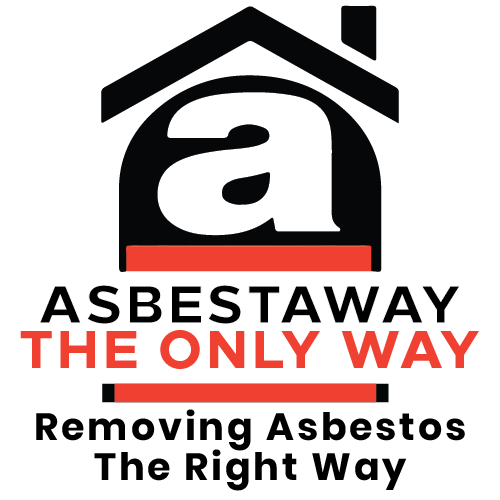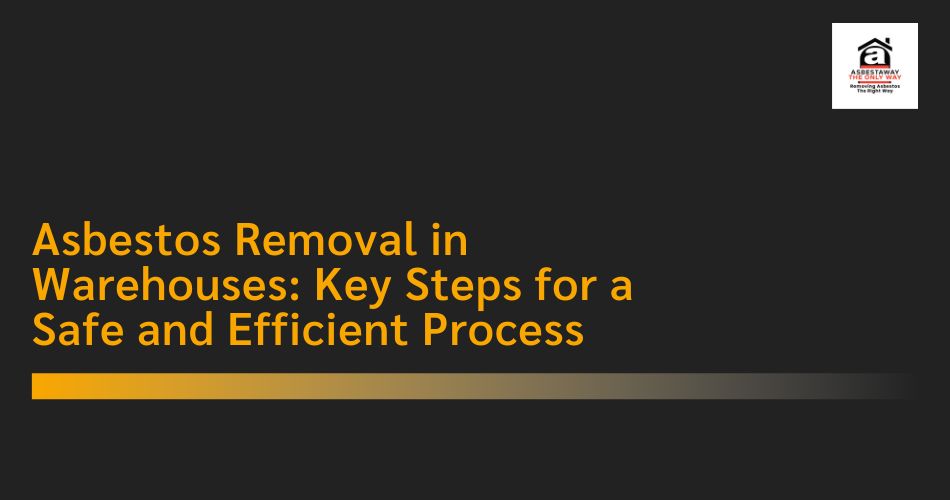Asbestos was once a widely used material in construction, including warehouses, due to its durability, fire resistance, and insulating properties. However, over the years, the serious health risks associated with asbestos exposure have become well-documented. When asbestos-containing materials (ACMs) deteriorate or are disturbed, they release microscopic fibres that can be inhaled, leading to serious health conditions such as lung cancer, asbestosis, and mesothelioma.
Asbestos removal in warehouses is a critical task to ensure the safety of workers, tenants, and visitors. Given the scale of warehouses and the potential for hidden asbestos-containing materials, this process can be complex. It is essential to follow strict protocols and safety measures to effectively manage asbestos risks. This blog will explore the key steps involved in asbestos removal in warehouses, ensuring a safe and efficient process. Additionally, we will highlight the services of Asbestaway, a trusted provider for asbestos management and removal.
The Role of Asbestos in Warehouse Construction
Asbestos Use in Warehouse Buildings
Asbestos was commonly used in the construction of warehouses during the mid-20th century until its ban in Australia in 2003. The mineral’s properties made it particularly appealing for commercial and industrial use. Some of the most common asbestos-containing materials (ACMs) found in warehouses include:
- Roofing Materials: Asbestos was frequently used in corrugated roofing sheets and panels due to its fire-resistant properties and durability. These roofing materials are often found in older warehouses and can still pose a risk today if they deteriorate or are disturbed during maintenance or renovation activities.
- Insulation Materials: Asbestos was widely used in the insulation of pipes, walls, and ducts in warehouses. These materials were designed to protect buildings from extreme temperatures and reduce energy consumption. However, over time, asbestos insulation can degrade, releasing fibres into the air.
- Flooring and Tiles: Asbestos-containing vinyl tiles and linoleum were often used in warehouse floors for their durability and ease of maintenance. These tiles, while safe if undisturbed, can release harmful fibres if they are damaged or removed incorrectly.
- Wall Cladding and Ceiling Panels: Asbestos cement sheets were used in cladding and ceiling panels to provide additional strength and fire resistance. These materials can become a hazard when renovations or repairs are undertaken.
- Fireproofing Materials: Asbestos was often used for fireproofing various components of warehouse buildings, such as structural steel beams, to enhance fire resistance. These fireproofing coatings can be highly hazardous if disturbed during construction work.
Asbestos may still be present in many older warehouses, and identifying it early is essential for ensuring the safety of workers and other individuals on-site.
Health Risks of Asbestos Exposure in Warehouses
The Dangers of Asbestos in the Warehouse Environment
Exposure to asbestos fibres in a warehouse environment can lead to several severe health conditions, many of which may not appear until many years after initial exposure. These health risks include:
- Asbestosis: Asbestosis is a chronic lung disease caused by the inhalation of asbestos fibres. This disease leads to scarring of the lungs, making it difficult to breathe and leading to symptoms such as persistent coughing, shortness of breath, and chest pain.
- Lung Cancer: Prolonged exposure to asbestos significantly increases the risk of developing lung cancer. Workers who are exposed to asbestos fibres over time, particularly those who smoke, are at a higher risk.
- Mesothelioma: This rare but aggressive form of cancer affects the lining of the lungs, abdomen, or heart. Mesothelioma is directly linked to asbestos exposure and typically manifests decades after the initial exposure.
- Pleural Plaques and Pleural Thickening: These are signs of damage to the lining of the lungs, which can develop as a result of asbestos exposure. While not cancerous, they can indicate the presence of asbestos fibres in the lungs and increase the risk of other respiratory issues.
In a warehouse environment, employees may be at a higher risk of exposure, particularly if the building is undergoing renovation, demolition, or maintenance, and asbestos materials are disturbed or damaged.
Legal Regulations for Asbestos Removal in Australian Warehouses
Compliance with Australian Asbestos Legislation
In Australia, the removal and management of asbestos in warehouses are governed by strict laws and regulations aimed at protecting workers and the public. These regulations ensure that asbestos is safely handled, removed, and disposed of, minimising exposure risks.
Work Health and Safety (WHS) Act and Regulations
Under the Work Health and Safety (WHS) Act 2011, asbestos is considered a hazardous substance, and all workplace activities involving asbestos must be managed to ensure the safety of workers. The WHS regulations specify the following:
- Risk Assessment: A thorough risk assessment must be carried out before any work is conducted on a warehouse that may involve asbestos. This assessment will determine the type, condition, and location of any ACMs present, and the necessary steps to manage the risk.
- Licensing and Training: Only licensed asbestos removal contractors are permitted to carry out asbestos removal in Australia. These contractors must undergo specialist training to handle, remove, and dispose of asbestos safely.
- Safe Work Practices: Safe work practices, such as the use of protective equipment (PPE), asbestos containment systems, and decontamination procedures, are required during any asbestos removal activity.
The Code of Practice for the Safe Removal of Asbestos
The Code of Practice for the Safe Removal of Asbestos (2011) provides specific guidance on how to safely remove asbestos from warehouses. Some key provisions include:
- Developing an Asbestos Removal Plan: A detailed removal plan must be developed before starting work. This plan should address the scope of work, safety measures, removal procedures, and emergency protocols.
- Air Monitoring and Clearance Testing: Air monitoring should be conducted to ensure that no airborne asbestos fibres are present during and after the removal process. Clearance testing is also required to confirm that the work area is free from asbestos contamination before re-entry.
- Disposal of Asbestos Waste: Asbestos waste must be disposed of at licensed disposal facilities in accordance with local environmental regulations.
By adhering to these regulations, warehouse owners and contractors can ensure that asbestos removal is carried out safely, efficiently, and in compliance with the law.
Key Steps for Safe Asbestos Removal in Warehouses
Warehouse Asbestos Removal Process: Step-by-Step
The process of asbestos removal from warehouses requires careful planning, risk management, and execution. Below are the key steps involved in the safe and efficient removal of asbestos in a warehouse setting.
1. Site Inspection and Risk Assessment
The first step in asbestos removal is a comprehensive site inspection. A licensed asbestos assessor will conduct a thorough inspection of the warehouse to identify the presence of asbestos-containing materials (ACMs). This inspection will also include an assessment of the condition of these materials, as deteriorating ACMs pose a greater risk of fibre release.
The assessor will prepare a risk assessment based on the findings, detailing the hazards posed by any identified ACMs and recommending appropriate control measures.
2. Asbestos Removal Plan Development
Once the risk assessment is complete, an asbestos removal plan must be developed. This plan should outline the entire removal process, including:
- The specific areas of the warehouse that need to be addressed
- The asbestos removal methods to be used (e.g. wet removal, hand tools, or mechanical methods)
- The necessary containment measures to prevent fibre release
- The types of personal protective equipment (PPE) required for workers
- The procedures for decontamination and waste disposal
The plan must be reviewed and approved by the relevant regulatory authorities before any removal work begins.
3. Setting Up Containment and Protection Systems
During the removal process, strict containment measures must be implemented to prevent the spread of asbestos fibres. This may include:
- Establishing a Controlled Area: The area where the removal is taking place must be clearly marked and restricted to authorised personnel only.
- Using Airlocks and Negative Pressure Units: Negative pressure units should be used to create a vacuum effect in the work area, ensuring that any airborne fibres are contained and filtered out of the environment.
- Sealing the Work Area: Plastic sheeting, barriers, or enclosures should be used to seal off the work area to prevent asbestos dust from spreading to other parts of the warehouse.
4. Asbestos Removal and Disposal
Once the containment systems are in place, the asbestos removal can begin. All asbestos materials should be carefully removed using wet methods to minimise fibre release. For non-friable asbestos, mechanical tools may be used, while friable asbestos should be removed using hand tools to prevent disturbance.
After removal, all asbestos waste must be sealed in leak-tight containers and transported to a licensed asbestos disposal facility. Disposal records must be kept for compliance purposes.
5. Post-Removal Decontamination and Air Monitoring
After the asbestos has been removed, the work area must undergo thorough decontamination. This includes cleaning all surfaces using HEPA vacuums and wet wiping. Air monitoring should also be conducted to check for any airborne asbestos fibres in the surrounding environment.
Once air testing confirms that the area is free from contamination, the containment barriers can be safely removed.
6. Final Clearance and Certification
A final inspection is conducted by a licensed asbestos assessor to ensure that all asbestos has been removed and the area is safe for reoccupation. Clearance certificates are issued once the area has been verified as free from asbestos fibres.
Asbestaway: A Trusted Partner for Asbestos Removal in Warehouses
Why Choose Asbestaway for Warehouse Asbestos Removal?
Asbestaway is a leading provider of asbestos removal services in Australia, specialising in safe and efficient asbestos removal from warehouses. With years of experience in the industry, Asbestaway’s team of licensed professionals ensures that all asbestos removal projects are carried out in full compliance with Australian regulations.
Key Services Offered by Asbestaway
- Comprehensive Asbestos Surveys and Risk Assessments: Asbestaway provides thorough surveys to identify and assess the presence of asbestos in warehouses. Their risk assessments ensure that all potential hazards are identified and managed effectively.
- Licensed Asbestos Removal: Asbestaway offers licensed asbestos removal services for both non-friable and friable asbestos, using the latest containment methods and PPE to ensure worker and public safety.
- Asbestos Waste Disposal: Asbestaway handles all asbestos waste disposal in compliance with environmental regulations, ensuring that waste is safely transported to licensed disposal facilities.
- Emergency Asbestos Removal Services: In the event of unexpected asbestos discoveries, Asbestaway provides emergency removal services to prevent further exposure and minimise disruption.
By choosing Asbestaway, warehouse owners and operators can be confident that their asbestos removal needs will be handled with professionalism, safety, and expertise.
Conclusion: Ensuring Safe and Efficient Asbestos Removal in Warehouses
Asbestos removal in warehouses is a complex but critical process that must be handled with care and expertise. With strict regulations in place to protect workers and the public, warehouse owners and operators must ensure that any asbestos-containing materials are identified, safely removed, and properly disposed of.
By following the key steps outlined in this guide, including risk assessment, containment, and decontamination, warehouse asbestos removal can be conducted safely and efficiently. Partnering with a trusted asbestos removal provider such as Asbestaway ensures that the entire process is managed in compliance with Australian regulations and best practices, keeping all stakeholders safe.

